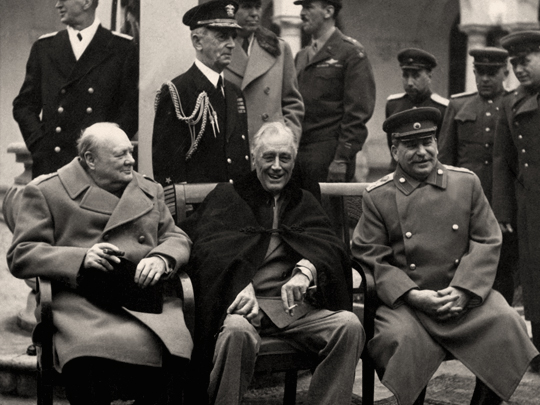Wikimedia Commons / CC-BY-SA-3.0 / GFDL
1 – Yalta Conference Takes Place Planning Final Defeat of Axis Powers
The Yalta Conference, held from February 4-11, 1945, was the meeting of the heads of government from the United States, the United Kingdom, and the Soviet Union, during World War II.
President Franklin D. Roosevelt, Prime Minister Winston Churchill, and Premier Joseph Stalin met to discuss Europe’s post-war reorganization.
The meeting, in the Livadia Palace near Yalta, Crimea, was intended mainly to discuss the re-establishment of the nations of war-torn Europe.
Within a few years, with the Cold War dividing the continent, Yalta became a subject of intense controversy.
Yalta was the second of three wartime conferences among the Big Three.
It was preceded by the Tehran Conference in 1943, and followed by the Potsdam Conference in July 1945, which was attended by Stalin, Churchill and Harry S. Truman, Roosevelt’s successor.
2 – Allies Secure Iwo Jima
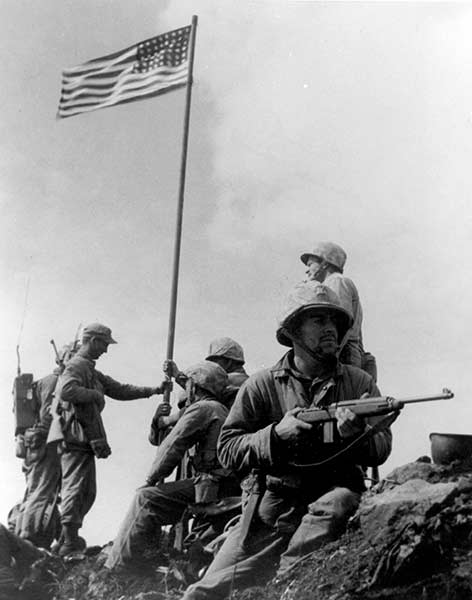
The Battle of Iwo Jima, 19 February – 26 March 1945, was a major battle in which the U.S. Marines captured the island of Iwo Jima from the Japanese Imperial Army during World War II.
The American invasion had the goal of capturing the entire island, including the three Japanese-controlled airfields, to provide a staging area for attacks on the Japanese main islands.
This five-week battle saw some of the fiercest and bloodiest fighting of the War in the Pacific theatre.
After the heavy losses incurred in the battle, the strategic value of the island became controversial. It was useless to the U.S. Army as a staging base and useless to the U.S. Navy as a fleet base.
However, Navy Seabees rebuilt the landing strips, which were used as emergency landing strips for USAAF B-29s.
The battle is remembered primarily by Joe Rosenthal’s Associated Press photograph of the raising of the U.S. flag on top of Mount Suribachi by five U.S. Marines and a U.S. Navy combat corpsman.
The photograph records the second flag-raising on the mountain, both of which took place on the fifth day of the 36-day battle.
3 – Tokyo Firebombing

The Bombing of Tokyo was conducted as part of the air raids on Japan by the United States Army Air Forces during the Pacific campaigns of World War II.
Strategic bombing and urban area bombing began in 1944 after the long-range B-29 Superfortress bomber entered service, first deployed from China and thereafter the Mariana Islands.
B-29 raids from those islands began on 17 November 1944 and lasted until 15 August 1945, the day Japan capitulated.
The Operation Meetinghouse air raid of 9–10 March 1945 was later estimated to be the single most destructive bombing raid in history.
Damage to Tokyo’s heavy industry was slight until firebombing destroyed much of the light industry that was used as an integral source for small machine parts and time-intensive processes.
Firebombing also killed or made homeless many workers who had been taking part in the war industry.
Over 50% of Tokyo’s industry was spread out among residential and commercial neighborhoods; firebombing cut the whole city’s output in half.
Emperor Hirohito’s tour of the destroyed areas of Tokyo in March 1945 was the beginning of his personal involvement in the peace process, culminating in Japan’s surrender six months later.
4 – Hitler Commits Suicide in his Bunker in Berlin
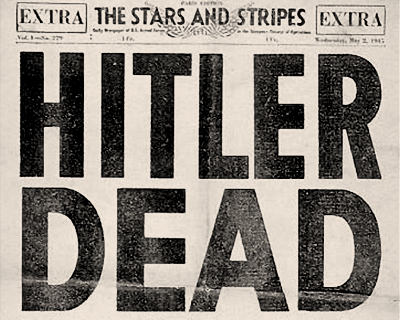
Adolf Hitler killed himself on 30 April 1945, in his Führerbunker in Berlin. His wife, Eva Braun, committed suicide with him by taking cyanide.
In accordance with Hitler’s prior instructions, their remains were doused in petrol and set alight in the Reich Chancellery garden outside the bunker.
According to reports from those in the bunker at the time, Hitler shot himself in the temple with a pistol.
Records in the Soviet archives show that their burnt remains were recovered and interred in successive locations until 1970, when they were again exhumed, cremated, and the ashes scattered.
The first news of Hitler’s death to the outside world came from the Germans themselves.
On 1 May the radio station Reichssender Hamburg interrupted their normal program for Grand Admiral Karl Dönitz to announce that Hitler was dead.
Dönitz called upon the German people to mourn their Führer, who died a hero defending the capital of the Reich.
Hoping to save the army and the nation by negotiating a partial surrender to the British and Americans, Dönitz authorized a fighting withdrawal to the west. His tactic was somewhat successful.
It enabled about 1.8 million German soldiers to avoid capture by the Soviets, but it came at a high cost in bloodshed, as troops continued to fight until 8 May
5 – Battle of Berlin Ends as Soviet Army Takes Berlin
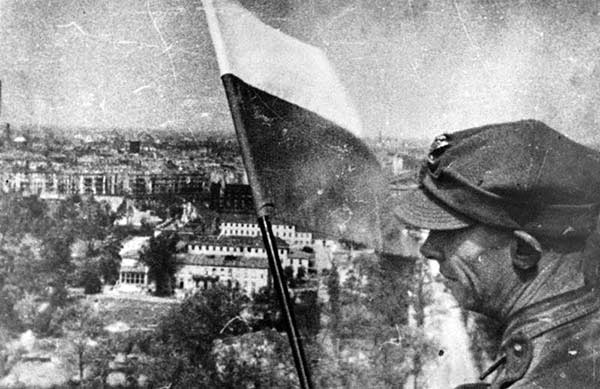
The Battle of Berlin was the final major offensive of the European theatre of World War II. Following the Vistula–Oder Offensive of January–February 1945, the Red Army had temporarily halted 60 km east of Berlin.
When the offensive resumed on 16 April, two Soviet groups attacked Berlin from the east and south, while a third overran German forces positioned north of Berlin.
Before the main battle in Berlin commenced, the Red Army encircled the city.
On 20 April 1945, the 1st Belorussian Front led by Marshal Georgy Zhukov started shelling Berlin’s city center, while Marshal Ivan Konev’s 1st Ukrainian Front pushed through from the south.
The German defenses were mainly led by Helmuth Weidling. The units consisted of several depleted and disorganized Wehrmacht and Waffen-SS divisions, along with poorly trained Volkssturm and Hitler Youth members.
Within the next few days, the Red Army reached the city center where close-quarters combat raged. Before the battle was over, German Führer Adolf Hitler and some of his followers committed suicide.
The city’s defenders surrendered on 2 May, but fighting continued in parts of the city until the end of the war in Europe on 8 May.
This was due to German units fighting westward so that they could surrender to the Western Allies rather than the Soviets.
6 – VE Day – Germany Signs an Unconditional Surrender
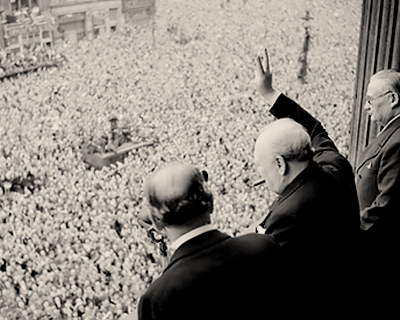
Victory in Europe Day, generally known as VE Day, was the public holiday celebrated on 8 May 1945 to mark the formal acceptance by the Allies of Nazi Germany’s unconditional surrender of its armed forces.
This marked the end of World War II in Europe.
The term VE Day existed as early as September 1944, in anticipation of victory. Germany’s surrender was authorized by Hitler’s successor, Karl Dönitz.
The administration headed by Dönitz was known as the Flensburg Government. The act of military surrender was signed on 7 May in Reims, France and on 8 May in Berlin, Germany.
The former Soviet Union and Eastern Bloc countries have historically celebrated the end of World War II on 9 May.
However, the Baltic countries now commemorate VE day on 8 May. In Ukraine from 2015, 8 May was designated as a day of Remembrance and Reconciliation.
7 – Atomic Bombs Dropped on Hiroshima & Nagasaki

The United States, with the consent of the United Kingdom in the Quebec Agreement, dropped nuclear weapons on the Japanese cities of Hiroshima and Nagasaki on August 6 and 9, 1945, during the final stage of World War II.
The two bombings remain the only use of nuclear weapons for warfare in history.
In the final year of the war, the Allies prepared for what was anticipated to be a very costly invasion of the Japanese mainland.
This was preceded by a U.S. firebombing campaign that destroyed 67 Japanese cities and killed 393,000 people.
The Japanese refused to accept the Allies’ demands for unconditional surrender and the Pacific War continued.
Together with the United Kingdom and China, the United States called for the unconditional surrender of the Japanese armed forces in the Potsdam Declaration on July 26, 1945.
The alternative being “prompt and utter destruction”. The Japanese response ignored the ultimatum.
On August 6, the U.S. dropped a uranium gun-type atomic bomb (Little Boy) on Hiroshima.
U.S. President Harry S. Truman called for Japan’s surrender 16 hours later, warning them to “expect a rain of ruin from the air, the like of which has never been seen on this earth.”
Three days later, on August 9, the U.S. dropped a plutonium implosion-type bomb (Fat Man) on Nagasaki.
Within the first two to four months of the bombings, the acute effects of the atomic bombings killed 90,000–146,000 people in Hiroshima and 60,000–80,000 in Nagasaki.
During the following months, large numbers died from the effect of burns, radiation sickness, and other injuries, compounded by illness and malnutrition.
On August 15, six days after the bombing of Nagasaki and the Soviet Union’s declaration of war, Japan announced its surrender to the Allies.
On September 2, it signed the instrument of surrender, effectively ending World War II. The bombings’ role in Japan’s surrender and their ethical justification are still debated.
8 – VJ Day – Japan surrenders Unconditionally
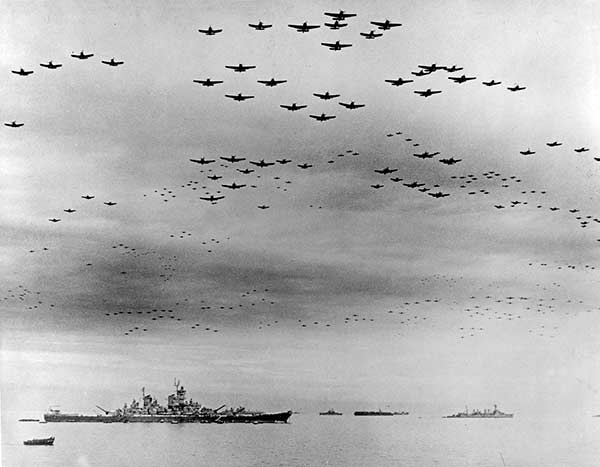
Victory over Japan Day is the day on which Japan surrendered in World War II, in effect ending the war.
August 15 is the official V-J Day for the UK, while the official U.S. commemoration is September 2.
The name, V-J Day, had been selected by the Allies after they named V-E Day for the victory in Europe.
On September 2, 1945, a formal surrender ceremony was performed in Tokyo Bay, Japan, aboard the battleship USS Missouri, officially ended the war.
In Japan, August 15 is usually known as the “memorial day for the end of the war”.
The official name for the day, however, is “the day for the mourning of war dead and praying for peace”.
9 – World War II Ends
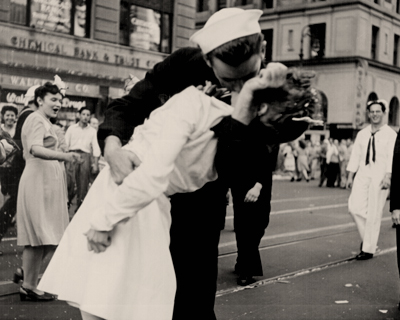
The announcement of the end of the war in Japan was made by U.S. President Harry S. Truman, jubilation ensued. This photo was taken on VJ Day in Times Square.
The iconic photo of a U.S. Navy sailor grabbing and kissing a woman in a white dress in New York City’s Times Square on August 14, 1945.
Life Magazine had a two-page spread with this and three other kissing poses among celebrators in Washington, D.C., Kansas City, and Miami.
Kissing was a favorite pose encouraged by media photographers of service personnel during the war, but this was a spontaneous moment that was immortalized.
10 – Puyi, the Last Chinese Emperor, was Captured by Soviet Troops
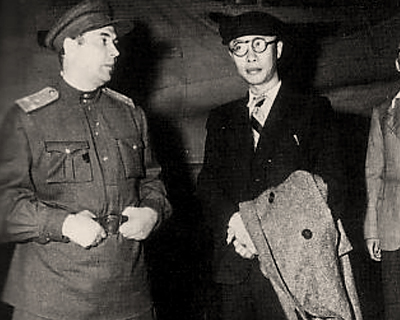
Puyi, commonly known as Henry Pu Yi, was the last Emperor of China and the twelfth and final ruler of the Qing dynasty.
As a child, he ruled as the Xuantong Emperor from 1908 until his forced abdication on 12 February 1912, after the successful Xinhai Revolution.
From 1 to 12 July 1917, he was briefly restored to the throne as emperor by the warlord Zhang Xun.
In 1932, after the occupation of Manchuria the state of Manchukuo was established by Japan, and he was chosen to become ‘Chief Executive’ of the new state using the era-name of Datong.
In 1934, he was declared the Kangde Emperor of Manchukuo and ruled until the end of the Second Sino-Japanese War in 1945.
At the end of World War 2, he was captured by the Soviet Red Army on 16 August 1945, while he was in an airplane fleeing to Japan.
The Soviets took him to the Siberian town of Chita. He lived in a sanatorium, then later in Khabarovsk near the Chinese border.
After the People’s Republic of China was established in 1949, Puyi was imprisoned as a war criminal for 10 years, wrote his memoirs and became a titular member of the National People’s Congress.
